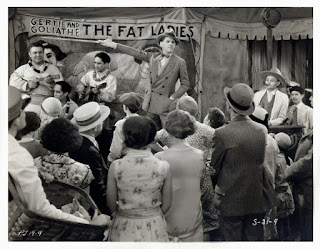Sheridan movie buffs rejoice!
Silent movies were all the rage for Sheridanites in the teens and twenties of the last century, but the trend was soon to change. On April 18th, 1929, the first sound movie shown in Sheridan, legendary director John Ford's new film, Four Sons, opened at the Lotus Theater (now the Wyo Theater).
| Four Sons poster from the April 16, 1929 edition of the Sheridan Journal. Click to enlarge. |
(Fun fact: Four Sons featured a young John Wayne playing an officer.)
The new sound movies were known colloquially as 'talkies'. Four Sons wasn't a talkie, strictly speaking, but it did feature a music and effects track. The true talkie of the night, the 15-minute short film, The Carnival Man, opened with Four Sons, as well as the newsreel, "Fox Talking News," and a "grand opera selection," accompanied by a Fox 100-piece orchestra.
| Movie snapshot from the April 21 edition of the Sheridan Post-Enterprise. Click to enlarge. |
People flocked to the Lotus, with the first showing jam packed and folks waiting hours to see the second. Amid the fanfare and hoopla, it was the little Carnival Man, an "all-talkie dramatization of carnival life," that stole the show.
 |
| Scene from The Carnival Man. Image from IMDB.com. Click to enlarge. |
The Sheridan Post-Enterprise joined in the revelry, celebrating the spankin' new cinematic experience: "No more will Sheridan Cinema patrons have to contend with the trap-drummer's imitation of machine gunfire, horses [sic] hoofs several seconds too late, explosion of sound after the real explosion has settled, for Sheridan now boasts a complete equipment for movietone productions." Think going from mono to Dolby 7.0 Surround Sound.
Add expert testimony to boot. Engineer Fred Cole of the DeForest laboratory, who set up the Lotus for sound pictures, lauded the building, saying it was "the best theater for acoustics he has ever equipped." The Wyo Theater's acoustics are renowned to this day.
The big doin's extended beyond state-of-the-art explosions of sound. The Lotus upgraded to the then equivalent of widescreen, which "permit[ted] viewing the pictures from the side-wings of the stage with but little distortion" a softer, less grainy picture on a screen conducive to a "free flow of sound."
The then manager and co-owner of the Lotus, Fred Bezold, and co-owner James Young (who managed the Orpheum) enthusiastically praised the forthcoming event, making sure to encourage folks from Sheridan and surrounding areas to prop the monumental expense of installing new equipment:
| From the April 16, 1929 edition of the Sheridan Journal. Click to enlarge. |
(Apparently, this Arthur James person was dead on.)
